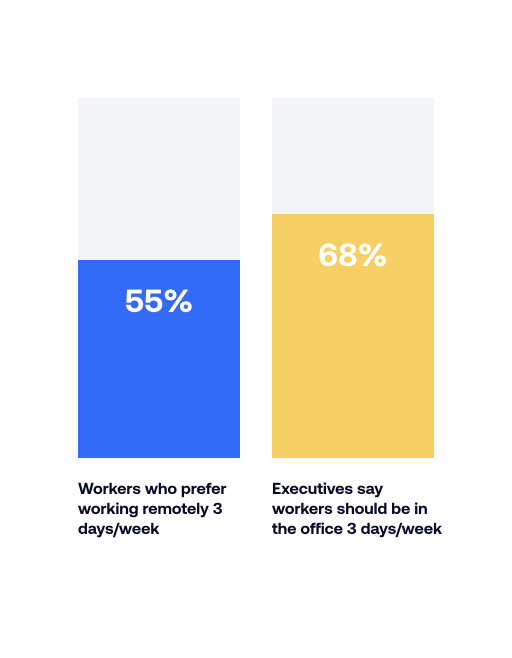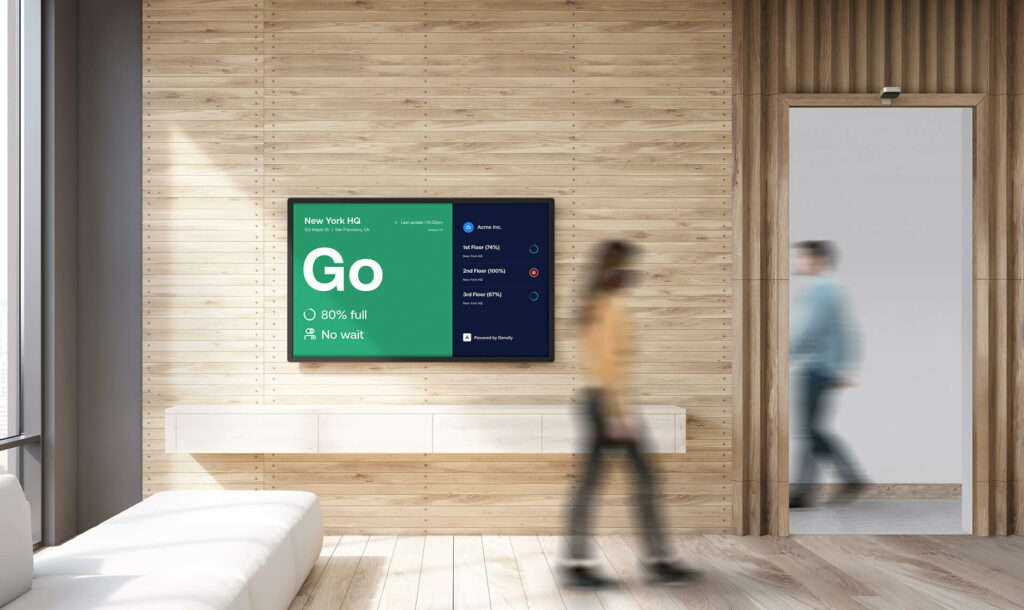Building your hybrid workplace culture
In a recent report out of Accenture, 83% of 9,326 workers surveyed say they prefer a hybrid model — in which they can work remotely at least 25% of the time.
Hybrid isn’t the new model of work. It is how a majority of employees now define work. And they expect employers to align with this perspective.
But there’s a disconnect between employers and employees. More than half (55%) of 1,200 workers surveyed late last year said they prefer working remotely three days a week. Meanwhile, 68% of 133 U.S. executives said workers should be in the office at least three days a week.

Execs’ biggest concern is that without a physical workplace, company culture will fall apart. But their concerns may be misguided.
“Your culture is not your office,” says Deniz Caglar, a partner at PwC and co-author of Fit for Growth: A Guide to Strategic Cost Cutting, Restructuring, and Renewal. “It’s what you do as an organization, how you work together. What you do does not change because you’re working virtually.”
Still, hybrid work complicates how you organize your workweek. It will change how, where, and possibly when work gets done. It will redefine how people use your office space.
So what can your organization do to redefine how you work together, no matter where and when work takes place? How can you build a hybrid workplace culture?
Make hybrid flexible

Hybrid work doesn't work for everyone. Age, experience, job duties, and personality all impact an employee’s willingness or ability to work well in a hybrid environment.
We really want people to have the ability to choose where and how they work.
Sameer Pangrekar, Twitter
Generational
74% of Gen Zers want more opportunities to collaborate with colleagues in person — compared to Gen Xers (66%) and Baby Boomers (68%)
A poll of 2,802 adults conducted in July 2020 found that Gen Zers are more likely to report their productivity has dropped since working from home
Younger generations are more likely to want face-to-face time with colleagues. But supporting their needs means thinking beyond just office space types. Commuting benefits and flexibility in your organization’s scheduling makes it easier for those who want to come to the office to collaborate.
Job duties
Not all employees can, or should, work away from the office. Employees who meet with clients, showcase products and services, or collaborate on projects benefit from an office. Many of these employees see the office as a place for collaboration and meetings. Employees who spend 4-6 hours at a desk alone can easily work from home. Still, they may want to come to the office on occasion for heads-down work.
In other words, you can make safe assumptions about which employees will use the office more frequently and for what purposes. But design with agility to support all possible scenarios. You may assume the hybrid workplace = collaboration and meeting spaces. But some employees want to work heads-down, alone, at the office.
Tenure
New hires benefit from working closely with their supervisors and teams. Julia Wuench, Founder of The Authenticity Guide, writes that fallbacks of virtual onboarding include:
- Ambivalence about the company
- Lack of connection
- Physical isolation and no personal relationships with colleagues
- Breakdown of communication if procedures, systems, and software tools aren’t implemented
Remote onboarding struggles can equate to higher employee turnover rates and wasted resources looking for new candidates.
Remote onboarding, of course, is becoming standard in the post-COVID world. Leaders must ensure all new and promoted employees feel supported. Documentation of your procedures, mission, and employee expectations is a central part of democratizing the onboarding experience for all employees. But don’t just document company knowledge — maintain it. Appoint employees as maintainers of key internal documents, and have them regularly review these documents.
Personality
Some people thrive on social relationships. They see camaraderie as a central part of how they define work. Others, however, enjoy working independently. This isn’t to say they’re introverts. Many extroverts don't need to work face-to-face with colleagues.
This is important to acknowledge as you flesh out your hybrid workplace. Just because someone works in a department that supports remote work doesn’t mean that an employee wants to work from home. Making team-based decisions can be effective but is not always the best. Allow some flexibility so individual employees can choose where they work without feeling like they’re going against the office ‘norm.’
Build Trust

Employees coming to the office don’t trust that workplace leaders have their health and safety as top priorities. Employees working from home don’t trust that leaders will think of them for promotions and career advancement opportunities.
Business leaders need to collaborate on comprehensive policies and procedures that build confidence in their workforce and workplace.
— Edward Wagoner, JLL Technologies
Trust in the workplace
Arm employees with the data they need to make their own decisions on where to work. Examples:
- Make it easy for employees to know how many people are working in a space — before they arrive.
- Create documents and procedures that address the evolving health and safety concerns of the post-pandemic workplace.
- Be transparent. Share updates with your organization on changes you've made to policies — and why.
Wise, for example, has sent weekly updates on what has changed in each of its 16 locations across the globe.
That way, everyone is informed, updated, and knows what kind of safety measurements we are taking.
Liis Resiner, Workplace Project Manager at Wise
Trust for remote employees
Make resources available to remote workers. These resources range from job autonomy and positive mental health to supportive leadership and your company’s commitment to adopting cutting-edge technology. It also means ensuring you have procedures in place to recognize and reward employees explicitly based on performance.
Emphasize personal connections. So much of a remote employee’s experience with colleagues is task-related. Slack messages about a bug; Zoom calls for brainstorming. Factor in unstructured time for remote employees so they can just be with their colleagues.
Create a remote-work policy (a guideline your company uses to help your remote team feel empowered to do their best work). While your policy can include various things, we recommend including a Communication Standard (How your team communicates). Some examples include:
- What are your normal working hours (or core collaboration hours?)
- What is the expected response time for each communication channel?
- What happens when someone is unavailable during regular working hours?
This policy ensures remote work isn’t an afterthought or seen as a perk. It's a natural part of your culture alongside vacation policies. Focusing on a communication standard will level the playing field for employees who miss out on serendipitous conversations at the water cooler.
Define, then redefine, hybrid work
Untitled
There isn’t one standard for what a hybrid workplace looks like. Nor should there be. Rich Benoit, Senior Consultant at furniture company Steelcase, explains:
“Just because I come into the office two days a week, doesn’t mean I only need a touchdown space because I’m there ‘part-time.’ I still need access to privacy, the ability to find my colleagues, and to be able to work in my rhythm."
Design for every option
Many companies assume their hybrid offices should feature more collaborative spaces. They think that if employees want to work alone, they’ll work from home. Not necessarily. Some employees can’t work heads-down at home. Others prefer not to. Designing a hybrid workplace means considering all the reasons why someone might come to the office. It isn’t always for a brainstorming session.
AB-test your space
Many workplace leaders we’ve talked with aren’t making any big space decisions yet. There are too many unknowns. Instead, they’ll AB-test their space. They’ll use data to observe employee behavior over time, then adjust their designs accordingly.
Patience is critical here. Employees don’t know what they want. They’ll continue to reevaluate their relationship with work for months to come — if not longer. This is a net-new experience for everyone.
It's one reason why Twilio's Sr. Manager of Global Workplace Operations, Devorah Rosner, has begun building hackable scrum spaces in Twilio's office space. So employees can design and redesign to fit their needs.
“We’re calling them dynamic spaces, with reconfigurable furniture,” she says. “It’s creating yet another way in which people can collaborate. So it’s no longer one-size-fits-all. It allows more variety to meet people where they are, to work how they work.”
Navigating the future
Hybrid work isn’t remote work. Supporting a hybrid work model is exponentially more complicated. Who works from home? Do you require employees to come to the office? If so, when?
And what should your space look like?
Traditional offices typically dedicate more than two-thirds of their space to individual, heads-down workspace. What new designs and technologies can provide flexibility and collaboration while still providing heads-down workspaces for employees who want it?
We've asked these questions to some of the leading workplace leaders in the industry. Find out 12 strategies folks from Zendesk, Twitter, and beyond are implementing at their workplaces. Get the guide here.